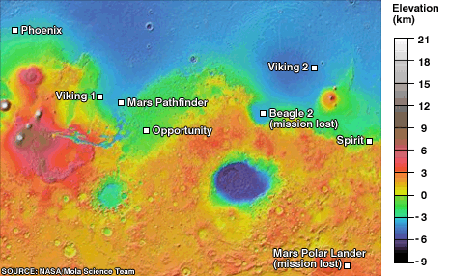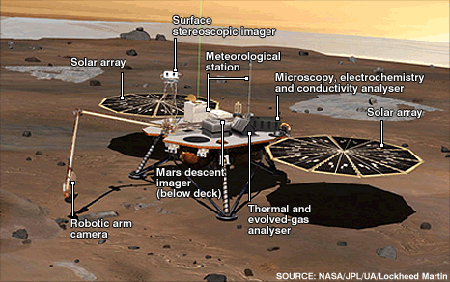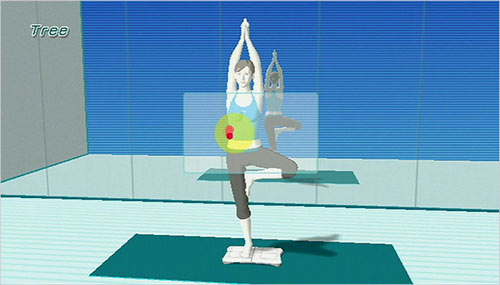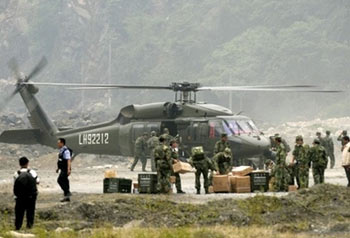You are hereFigures & Facts
Figures & Facts
NASA Mars Probe Prepares for Risky Landing
Original Source: BBC News
(quote)
The Phoenix lander is due to touch down on Monday in the far north of the Red Planet, after a 423-million-mile journey from Earth. The probe is equipped with a robotic arm to dig for water ice thought to be buried beneath the surface. Scientists say the mission should give the clearest indication yet of whether Mars could once have harbored life.
The final seven minutes of the probe's ten-month journey is regarded as the riskiest part of the mission. After it enters the top of the Martian atmosphere at nearly 5.7km/s (13,000 mph), the probe must perform a series of maneuvers to come safely to rest. It will release a parachute, use pulsed thrusters to slow to a fast walking speed, then come to a halt on three legs. If all goes to plan, the Phoenix lander will reach the surface of Mars at 0053 BST (1953 EDT) on May 26. Nasa controllers will know in about 15 minutes whether the attempt has been successful.
Landing on Mars is a notoriously tricky business. Of the 11 missions that have tried to land probes on Mars since 1971 - only five have succeeded. Phoenix is an apt name for the current mission, as it rose from the ashes of two previous failures. In September 1999, the Mars Climate Orbiter spacecraft crashed into the Red Planet following a navigation error caused when technicians mixed up "English" (imperial) and metric units. A few months later, another Nasa spacecraft, the Mars Polar Lander (MPL), was lost near the planet's South Pole. Phoenix uses hardware from an identical twin of MPL, the Mars Surveyor 2001 Lander, which was cancelled following the two consecutive failures. The probe was launched on 4 August 2007 on a Delta II rocket from Cape Canaveral Air Force Station in Florida.
(unquote)



Fun, Fitness, and Games - Shigeru Miyamoto’s Newest Wii Fit
Original Source: New York Times
(quote)
IT’S O.K. to liken Shigeru Miyamoto to Walt Disney. When Disney died in 1966, Mr. Miyamoto was a 14-year-old schoolteacher’s son living near Kyoto, Japan’s ancient capital. An aspiring cartoonist, he adored the classic Disney characters. When he wasn’t drawing, he made his own toys, carving wooden puppets with his grandfathers’ tools or devising a car race from a spare motor, string and tin cans. Even as he has become the world’s most famous and influential video-game designer — the father of Donkey Kong, Mario, Zelda and, most recently, the Wii — Mr. Miyamoto still approaches his work like a humble craftsman, not as the celebrity he is to gamers around the world.
Perched on the end of a chair in a hotel suite a few dozen stories above Midtown Manhattan, the preternaturally cherubic 55-year-old Mr. Miyamoto radiated the contentment of someone who has always wanted to make fun. And he has. As the creative mastermind at Nintendo for almost three decades, Mr. Miyamoto has unleashed mass entertainment with a global breadth, cultural endurance and financial success unsurpassed since Disney’s fabled career.
Mario, the mustached Italian plumber he created almost 30 years ago, has become by some measures the planet’s most recognized fictional character, rivaled only by Mickey Mouse. As the creator of the Donkey Kong, Mario and Zelda series (which have collectively sold more than 350 million copies) and the person who ultimately oversees every Nintendo game, Mr. Miyamoto may be personally responsible for the consumption of more billions of hours of human time than anyone around. In the Time 100 online poll conducted this spring, Mr. Miyamoto was voted the most influential person in the world.
But it isn’t just traditional gamers who are flocking to Mr. Miyamoto’s latest creation, the Wii. Eighteen months ago, just when video games were in danger of disappearing into the niche world of fetishists, Mr. Miyamoto and Satoru Iwata, Nintendo’s chief executive, practically reinvented the industry. (Mr. Miyamoto’s full title is senior managing director and general manager of Nintendo’s entertainment analysis and development division.) Their idea was revolutionary in its simplicity: rather than create a new generation of games that would titillate hard-core players, they developed the Wii as an easy-to-use, inexpensive diversion for families (with a particular appeal to women, an audience generally immune to the pull of traditional video games). So far the Wii has sold more than 25 million units, besting the competition from Sony and Microsoft.
Last week Nintendo released its new Wii Fit system in North America, a device that hopes to make doing yoga in front of a television screen almost as much fun as driving, throwing, jumping or shooting in a traditional game. Though there were no hard sales figures available as of Tuesday, there were reports of stores across the country selling out of Wii Fit.
(unquote)


Social Networks and Kicking Bad Habits - Quitting Smoking Can Be Contagious
Original Source: Reuters
(quote)
The same team of experts who found that obesity may be socially contagious said they found similar patterns among smokers, with people clearly influencing others in their social and family networks. In fact, the most isolated people are now those who remain the most addicted as their personal networks get pushed to the fringes, they wrote in the New England Journal of Medicine.
Dr. Nicholas Christakis of Harvard Medical School in Boston and Dr. James Fowler of the University of California, San Diego, studied 12,067 people who have been taking part in the Framingham study -- a study of the health and habits of nearly an entire town in Massachusetts -- for the past 32 years. "We've found that when you analyze large social networks, entire pockets of people who might not know each other all quit smoking at once," Christakis said in a statement. "What appears to happen is that people quit in droves."
Smoking is becoming increasingly less common in the United States. In 1965, 42 percent of the population smoked, according to the U.S. Centers for Disease Control and Prevention. That number has fallen to around 20 percent. When the Framingham study started, around 37 percent of adults smoked. Spouses had strong effects -- when someone quit, his or her spouse was 67 percent less likely to continue smoking. Quitters influenced their brothers or sisters -- siblings were 25 percent less likely to smoke if one of them quit, while the friend of someone who kicked the habit was 36 percent less likely to smoke. Even co-workers are influential -- in small firms, a quitter could decrease smoking among peers by 34 percent.
Richard Suzman, who directs behavioral studies at the National Institute of Aging, said the research could influence policy. "The results suggest new and probably more powerful approaches to changing health behaviors, such as smoking, by careful targeting of small peer groups as well as single individuals," he said.
(unquote)
Images courtesy of Reuters and iStockPhoto


Beyond Blogs - How Blogs, Wikis, and Social Media Have Changed the Way Businesses Work
Original Source: BusinessWeek
(quote)
...blogs, it turns out, are just one of the do-it-yourself tools to emerge on the Internet. Vast social networks such as Facebook and MySpace offer people new ways to meet and exchange information. Sites like LinkedIn help millions forge important work relationships and alliances. These social connectors are changing the dynamics of companies around the world. Millions of us are now hanging out on the Internet with customers, befriending rivals, clicking through pictures of our boss at a barbecue, or seeing what she read at the beach. It's as if the walls around our companies are vanishing and old org charts are lying on their sides.
This can be disturbing for top management, who are losing control, at least in the traditional sense. Workers can fritter away hours on YouTube. They can use social networks to pillory a colleague or leak secrets. That's the downside, and companies that don't adapt are sure to get lots of it. But there's an upside to the loss of control. Ambitious workers use these tools to land new deals and to assemble global teams for collaborative projects. The potential for both better and worse is huge, and it's growing—and since 2005 the technologies involved extend far beyond blogs. read more »
Scientists Observe Birth of a Supernova, Captured on Camera For the First Time
Original Source: Spaceflight Now
(quote)
PRINCETON, NJ -- When she peered into the screen of her computer one day in January, Alicia Soderberg was supposed to see a small, dull glowing smudge in one corner, the evidence of a month-old supernova that would help her better understand the mystery of these huge exploding stars. What the Princeton University astronomer saw instead was anything but dull. As Soderberg and Edo Berger, a postdoctoral research associate at Princeton, studied the X-ray emissions conveyed from space by NASA's Swift satellite, they saw an extremely bright light that seemed to jump out of the sky. They didn't know it, but they had just become the first astronomers to have caught a star in the act of exploding. The once-in-a-lifetime event, described in a paper published in the May 22 issue of Nature, has transfixed the worldwide astronomical community.
Soderberg and Berger wanted to observe a supernova known as SN 2007uy in the spiral galaxy NGC 2770, located 90 million light years from Earth in the constellation Lynx. They could plan to do that because they are able to view images captured by the telescope a few hours after the observation merely by downloading the data from the Swift website. The sudden appearance nearby of the X-ray burst of the newer supernova, easily captured by the NASA satellite with multiple instruments that can detect gamma rays, X-rays and ultraviolet light, has set scientists on a new path. "This phenomenon had been predicted more than 30 years ago, but is now observed for the first time," said Roger Chevalier, the W.H. Vanderbilt Professor of Astronomy at the University of Virginia. "These are the earliest observations of light from a supernova after the central collapse that initiated the explosion."
In the Nature paper, Soderberg and 38 colleagues show that the energy and pattern of the X-ray outburst is consistent with what scientists would have expected to see in the birth of a neutron star -- a shock wave blasting through the surface of the original massive star. Until now, astronomers have only been able to observe supernovae brightening days or weeks after the event, when the expanding shell of debris is energized by the decay of radioactive elements forged in the explosion.
(unquote)
Photos Courtesy of AFP and NASA/Swift Science Team/Stefan Immler



U.S. Military Planes Fly Disaster Relief to China's Earthquake Zone
Original Sources: CNN, The Virginia Pilot and Star Bulletin
(quote)
The Department of Defense has delivered critically needed relief supplies to the earthquake-stricken Sichuan province, the Pentagon said Sunday. The two C-17 Globemaster aircraft carried food, water containers, blankets, generators, lanterns and various hand tools. U.S. Air Force C-17 Globemaster aircraft from Elemendorf Air Force Base, Alaska, and Hickam Air Force Base, Hawaii are making the flights directly to the airport at Chengdu, the largest city in Sichuan, officials reported.
Senior Capt. Guan Youfei, deputy director of the Foreign Affairs Office of the Chinese Ministry of National Defense and Army Brig. Gen. Charles W. Hooper, the U.S. military attache in Beijing, greeted the first of two U.S. aircrews delivering earthquake relief supplies to China.
The People's Republic of China sent more than $5 million in aid to the United States following Hurricane Katrina in September 2005.
More than 32,000 people are known dead from the 7.9 quake that hit May 12. About 250,000 are hurt, according to Chinese government releases. Thousands remain missing and are feared dead under the rubble.
So far, almost 60 aid organizations from 13 countries have provided assistance to China in the aftermath of the quake. Among the countries are India, France, Singapore, the Philippines and the United States. "This is a mission about people helping people, simply that. It's reaching out to them in their greatest time of need," said Col. Joe Kim, vice commander of the Hawaii Air National Guard's 154th Wing.
(unquote)
Photos Courtesy of AFP and Chris Vadnais | Air Force


Britain's Couch Potato Children Now among the Fattest in Europe
Original Source: Daily Mail
(quote)
British children are among the worst in a Europe-wide obesity league table, with around a third weighing more than they should. A couch potato lifestyle and a growing appetite for fast food is blamed for boys and girls weighing in near the top of a 27-country fat league.
Scottish girls take second place in the female rankings, with almost 33 per cent overweight. English girls are fourth, with 29.3 per cent too heavy for their height. The heaviest girls are in Portugal (34.3 per cent), while the slimmest are in Latvia and Lithuania (3.5 per cent overweight). Among the boys, Scotland was again second, with almost 35 per cent too heavy for their height. Only Spanish boys are heavier. English boys are in sixth place at 29 per cent - compared to the lean lads of Lithuania, where only 8 per cent are overweight. The figures, which were compiled by the IASO from government and scientific studies, come as British doctors warn they are treating children as young as two for obesity.
Obesity experts said the results could be partly explained by a couch potato lifestyle, in which TV dinners have replaced family meals and computer games are preferred to outdoor play. Dr Tim Lobstein, of the International Association for the Study of Obesity, said: "There is a big industry selling us more TV to watch, more computer games to play, more DVDs to sit and watch. There is a big industry promoting screen watching which is a sedentary behaviour and you just get fatter while you do it."
Dr Ian Campbell, medical director of the charity Weight Concern, said childhood obesity could only be tackled by parents, schools and government working together. Safe, accessible exercise facilities and nourishing and affordable meals should be a priority, he said.
(unquote)



















